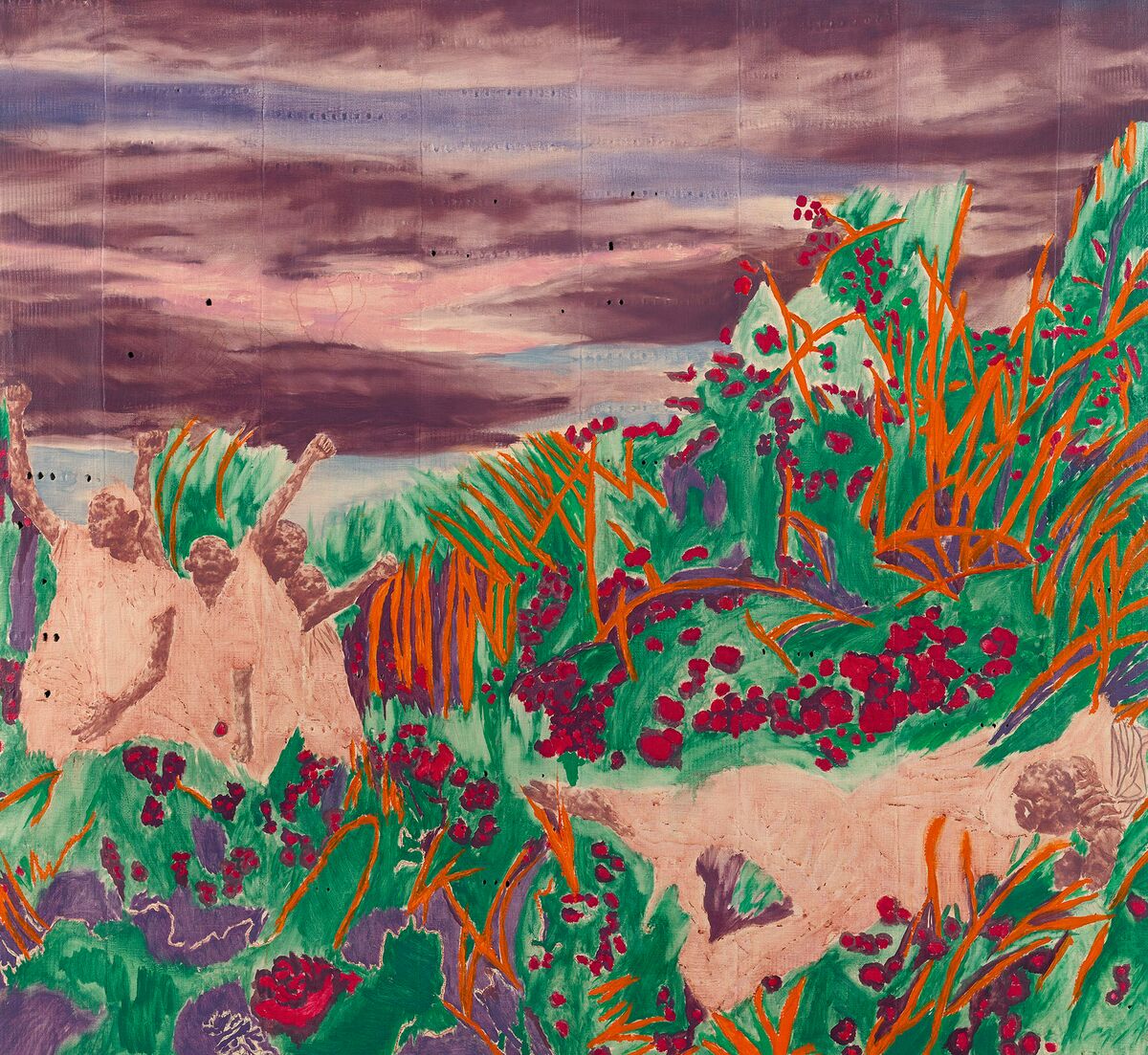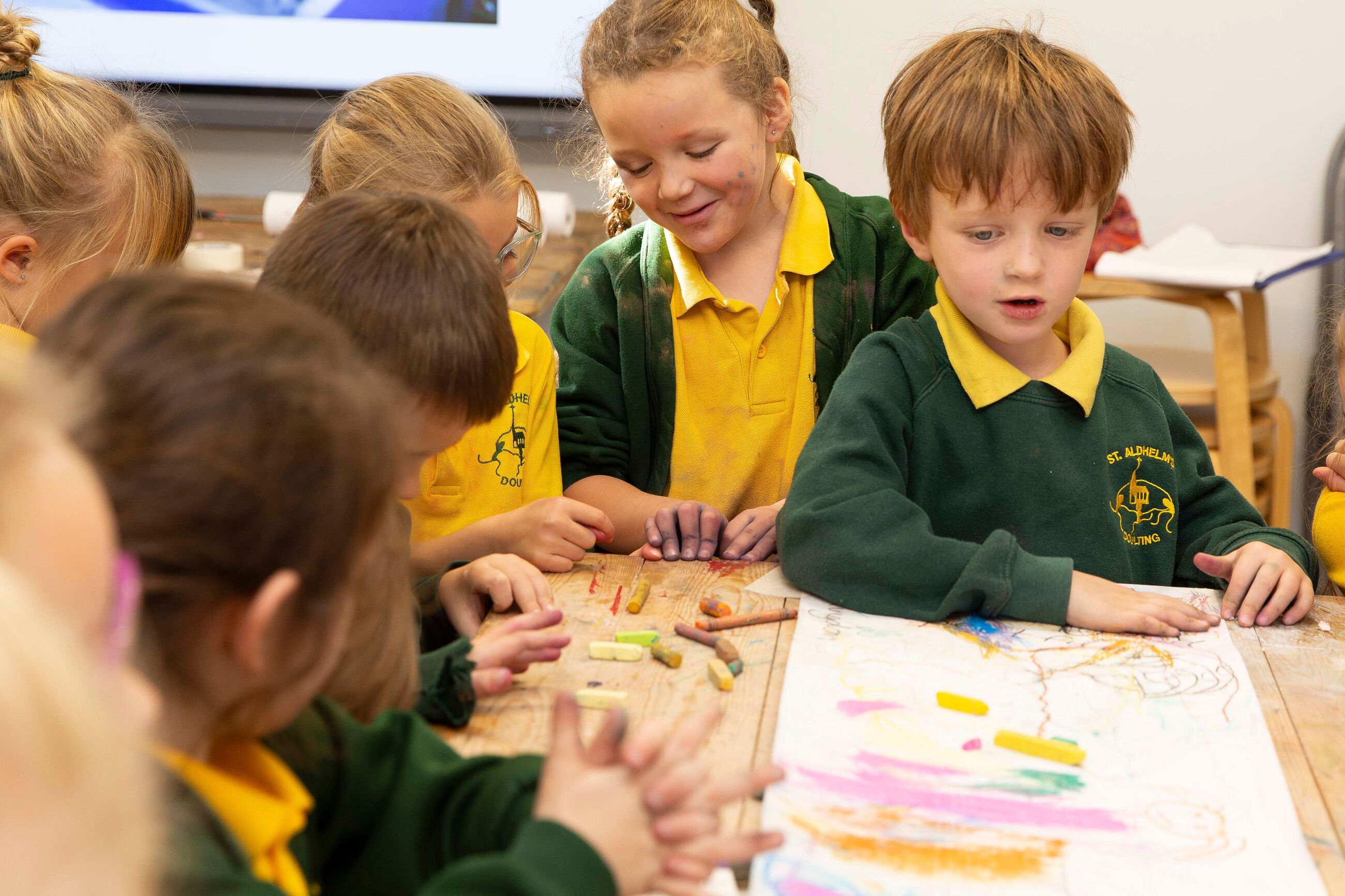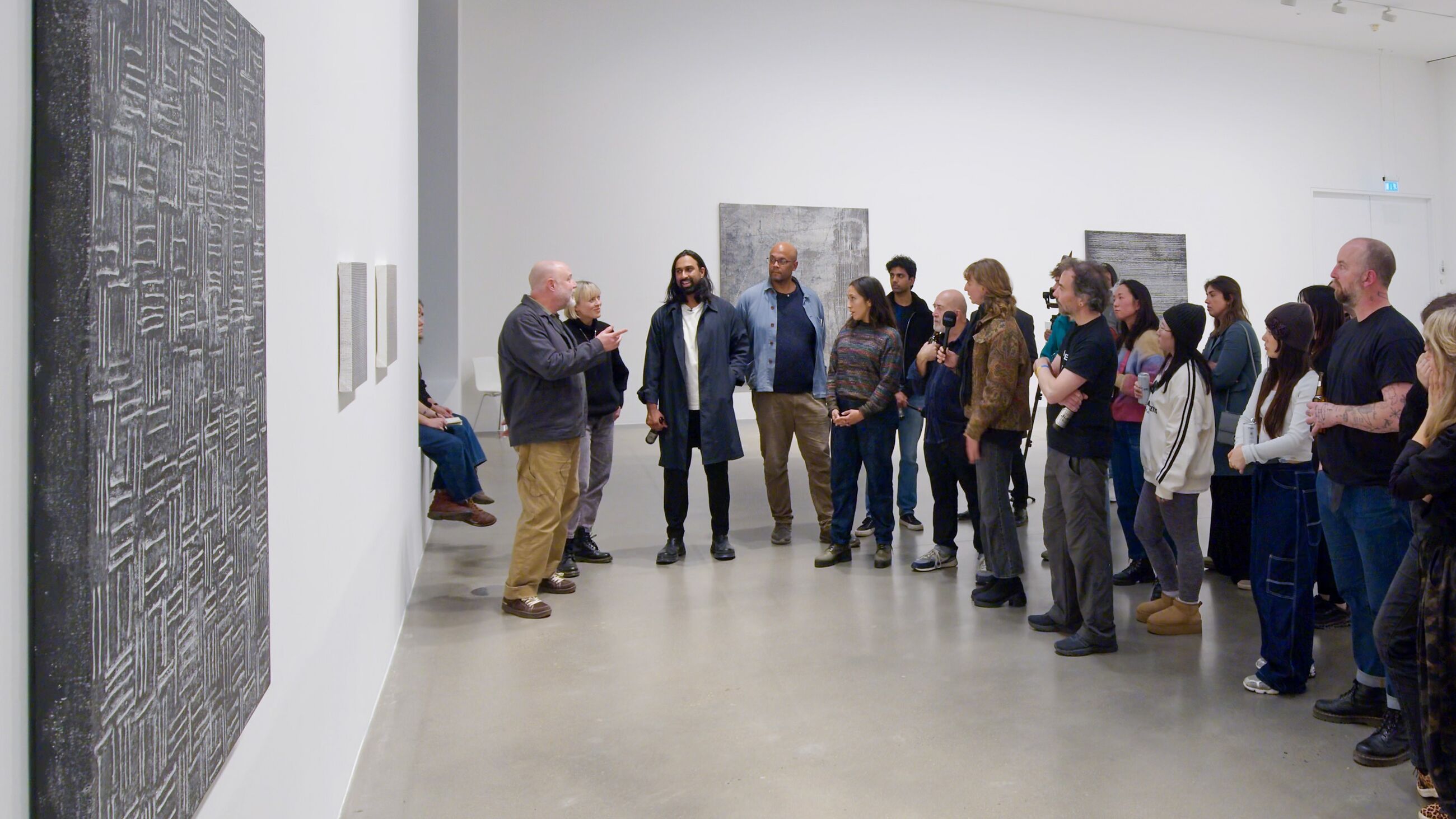Exhibition Learning Notes: ‘Jack Whitten. Speedchaser’

Jack Whitten in his 40 Crosby Street Studio in New York with paintings from the following series: ‘The Annunciation,’ ‘Ascension,’ ‘DNA,’ ‘Formal Relay,’ ‘Persian Echo,’ 1979 © Jack Whitten Estate
Exhibition Learning Notes: ‘Jack Whitten. Speedchaser’
This resource has been produced to accompany the exhibition ‘Jack Whitten. Speedchaser’ at Hauser & Wirth London from 7 October – 21 December 2024.
Click here to download a PDF version of this resource.
About Jack Whitten
Jack Whitten (1939 – 2018) was an African American abstract painter and sculptor, renowned for his experimental use of materials and techniques.
Born in Bessemer AL, he initially studied medicine at the Tuskegee Institute, but in 1960, he moved to New York NY to study art at The Cooper Union for the Advancement of Science and Art, where he gained his BFA degree. Whitten was influenced by abstract expressionism in the early stages of his career but eventually developed his own distinct methods and style of abstract painting. He was extremely wide-ranging and experimental in his use and application of materials incorporating collage, frottage and mosaics into his work. Growing up in the Southern United States, he saw first-hand the injustices of racism and segregation, and so was an active participant in the civil rights movement.
Later, the Greek island of Crete played a key role in the artist’s life thanks to his second wife Mary Staikos, who was of Greek parentage. Crete became a source of inspiration and site of refuge, with the couple making their first visit there in 1969. In the mid 1970s, Whitten started to journal his thoughts and reflections on his art, techniques and life in a studio log. Titling many of his entries ‘Notes from the Woodshed’ he would continue with this form of documentation until his death in 2018.
Whitten’s work is included in prestigious public and private collections around the world, including Museum of Modern Art, New York NY; The Metropolitan Museum of Art, New York NY; Whitney Museum of American Art, New York NY; National Gallery of Art, Washington DC; and Tate, London, UK.
‘I like to think of my studio as a laboratory where experiments are conducted.’—Jack Whitten

Installation view, ‘Jack Whitten. Speedchaser,’ Hauser & Wirth London © Jack Whitten Estate. Photo: Damian Griffiths
What does the exhibition look like?
The exhibition contains a selection of Whitten’s paintings, works on paper and sculptures from the 1970s, a period which is recognised as highly significant in the evolution of his creative practice. Work in both monochrome and colour is presented, with examples illustrating different series or bodies of work produced during that decade. Rare examples from what he termed his Greek Alphabet series, created between 1975 – 1978, are on display. These monochromatic abstract works, named after the 24 letter Greek alphabet, are painted in black and white acrylic, and were deliberate attempts by Whitten to reduce and restrict his use of colour so that he might better understand the tonal and structural qualities of colour itself. The use of the Greek alphabet also had a practical purpose for the artist.
‘The idea was to make a series of paintings using the Greek alphabet as titles in order to deter any specific romantic or emotional involvement with titles.’—Jack Whitten

Jack Whitten, Xzee III, 1977 © Jack Whitten Estate. Photo: Thomas Barratt

Jack Whitten, Xeroxed!, III, 1975 © Jack Whitten Estate. Photo: John Berens
The work ‘Xzee III’ (1977) for instance illustrates the deep visual influence that Greek culture had on the artist. The horizontal and vertical lines in the painting recall the geometric patterns often seen in the arts of Ancient Greece.
Other works such as ‘Xeroxed!, III’ (1975) point to Whitten’s early experimentation with photographic technologies such as xerography (electrophotography). During this period, the artist undertook a residency with the Xerox Corporation. He was inspired by the new technology and subsequently began applying toner directly onto canvas on paper, utilizing heat lamps to set the images.
‘The Speedchaser’ (1975) lends its name to the overall exhibition. It is a prelude to the Greek Alphabet paintings. Whitten uses a significant amount of acrylic paint which he then raked over with his self-made tool known as the developer. Due to financial constraints, he began mixing/diluting acrylic paint with crystalline silica and graphite, which enabled him to stretch and optimize the materials. The title suggests motion and dynamism, something created at speed, almost instantaneously like a photograph, thereby removing the presence of the artist and allowing the viewer to engage directly with the visual properties of the painting.
‘Speed was the essence of AbEx and my intention was to run faster than de Kooning!’—Jack Whitten

Jack Whitten, The Speedchaser, 1975 © Jack Whitten Estate. Photo: Sarah Muehlbauer

Jack Whitten, Reliquary For Orfos, 1978 © Jack Whitten Estate. Photo: Genevieve Hanson
A selection of the artist’s carved and assembled sculpture is also on display. These works, consisting of carved wood and a range of found materials such as glass, marble, bone, nails and fishing line, were mostly created while Whitten and his family stayed in the Cretan village of Agia Galini in the summer. For example, ‘Reliquary for Orfos’ (1978), made from mulberry wood and containing the bones of the Orfos fish, hints at the degree to which the artist drew from his local environment in the creation of these mostly private works of art.
How does he make his work?
Throughout the 1970s, Whitten began to create his work in a more mechanical method, decisively breaking away from the gestural approach of the abstract expressionists. He intentionally moved his workstation to the floor and decided not to use paint brushes. In place of the brush, he devised innovative handmade tools which he termed ‘developers’ or ‘processors’ such as rakes, rubber squeegees, saws and Afro combs to spread, pull and drag wet paint across the surfaces to create work he called ‘Slab’ paintings. He experimented with limiting his colour palette to variations of grey. His focus on Greek letters to create new inventive compositions freed him from art historical associations to the paint brush, mark-making, colour, and gave titles to his work. Whitten also developed new innovative techniques in frottage by placing found objects such as metal sheets, pebbles and wire under his canvas to create what he termed ‘disruptions’.
Beginning in 1970, he began to make his own acrylic paint, experimenting with its texture by adding graphite or silica creating a liquid he called ‘slip’, a term usually connected to ceramic making. He also manipulated the canvas he worked on by scoring it with ruled and free lines using items such as string, screw drivers and saw blades. He often drilled into painted canvases filling the holes with extra paint to assess how that might affect the overall colour and structure of the work. An awareness and use of technology regularly featured in Whitten’s working practice as is made clear from an entry in his studio log.
‘Xerox toner can be used as a pastel or powder and made permanent by applying heat; this means no fixative necessary + no change of colors. I plan to do drawings using this technique and also experiment with it on canvas.’—Jack Whitten
What are his sources of subject matter?
Throughout the 1970s, Ancient Greek civilisation, mythology and symbolic meanings embedded within the Greek alphabet itself, were primary sources of subject matter for the artist.
Whitten’s African American identity, and his investigation of this identity in a contemporary and historic context, were vital areas of subject matter influencing both his painted and sculptural output. He was constantly looking at the history of art and the ‘masters’ that came before him. He made it his goal to distinguish himself from the abstract expressionists and to redefine what it meant to be a painter.
Music and how its composition could be conceived as being textural and sweeping in sound was a subject matter the artist regularly drew upon. Whitten described music as ‘sheets of sound’ which led to him describing his paintings as ‘sheets of light’.
‘In the same way a musician experiments with sound, I experiment with the materials and techniques in my art.’—Jack Whitten
Whitten’s interest in science, particularly the field of quantum mechanics, was an area he drew inspiration and subject matter from throughout his career. The nature of reality and questions on matter and space were abstract concepts he explored in his artwork. For instance, he stated in his studio notes there was ‘no horizon’ in his paintings and that he was ‘space travelling’.

Installation view, ‘Jack Whitten. Speedchaser,’ Hauser & Wirth London © Jack Whitten Estate. Photo: Damian Griffiths
What are the major themes within the exhibition?
Abstraction and process
Whitten’s investigations into abstraction and the processes of how a painting is created are central themes in the exhibition. The physical material nature of paint is in itself a core theme. Bodies of work such as the Greek Alphabet series (1975 – 1978) allowed the artist to work with the abstract nature of letters to explore variations of shape, colour and spatial relationships.
Cultural identity
The artist’s exploration of his African American identity is an important theme across many of the works in the exhibition. The black and white drawings and paintings are both an investigation into the properties of colour and tonality, yet at the same time are a commentary on racism and segregation in the United States. His carved and sculpted works can also be seen as a personal and private connection to historic African sculpture not tainted or demeaned by an often tokenistic and simplified appropriation in western art history.
Experimentation
The 1970s was a radical period of experimentation for the artist. Along with his pushing at the boundaries of what a painting could be he was also experimenting with new tools of making a painting, resulting in his ‘developers’ or ‘processors’. This experimentalism and openness to the element of chance in dictating the course that his work would ultimately take are important themes running through the exhibition.
‘I am very much aware of the meaning of black and white in American society, which informs who I am as an African American. The formal reasons for black and white are one thing but there are also the reasons coming out of the political situation, and I wanted to see if I could combine them.’—Jack Whitten
What other artists does his work relate to?
Sam Gilliam (b.1933) is an African American abstract artist renowned for his explorations of light and color in his work and blurring the lines between painting and sculpture. Themes of identity and the cultural experiences of African Americans are important reference points for Gilliam’s artwork.
Willem de Kooning (1904 – 1997) was a Dutch American abstract expressionist artist known for his powerful and dynamic style of painting.
Ellsworth Kelly (1923 – 2021) was an American painter and sculptor who utilized vibrant colors to evoke emotion and feeling in his paintings. Simple geometric forms and cut-outs are also a feature of his practice.
Norman Lewis (1909 – 1979) was an influential African American artist known for his contributions to abstract expressionism.
Barnett Newman (1905 – 1970) was an American abstract painter renowned for his use of bold colors and interest in the spatial relationships between color and form. He is considered one of the key artists of abstract expressionism.
Mark Rothko (1903 – 1970) was an American painter renowned for his contributions to abstract expressionism. He is best known for his large canvases with rectangular fields of color that evoked deep emotional responses from viewers.
Hauser & Wirth artists to consider
Frank Bowling (b.1934) is a London-based artist whose practice has expanded the possibilities and properties of paint over the past 50 years. His highly individual language of painting emerged from expressionistic figuration and pop art, incorporating autobiographical elements and the artist’s sociopolitical concerns.
Mark Bradford (b.1961) is a contemporary artist best known for his large-scale abstract paintings. Characterized by its layered formal, material and conceptual complexity, Bradford’s work explores social and political structures that objectify marginalized communities and the bodies of vulnerable populations.
Charles Gaines (b.1944) is a key figure in the field of conceptual art. His body of work engages formulas and systems that interrogate relationships between the objective and the subjective realms.
Glenn Ligon (b.1960) is an artist living and working in New York NY. Throughout his career, Ligon has pursued an incisive exploration of American history, literature and society across bodies of work that build critically on the legacies of modern painting and conceptual art.

Installation view, ‘Jack Whitten. Speedchaser,’ Hauser & Wirth London © Jack Whitten Estate. Photo: Damian Griffiths
Glossary
Abstract expressionism
An art movement that emerged in New York NY in the 1940s and 1950s that emphasized abstraction over realistic depiction. A key concern for artists connected with the movement was representing emotional intensity through expressive brushwork. Notable artists include Jackson Pollock, Willem de Kooning and Mark Rothko.
Civil rights movement
A social justice movement in the United States in the mid-20th Century aimed at ending racial segregation and discrimination against the country’s African American communities.
Collage
The assembling of different materials such as paper, photographs, fabrics and other objects onto a surface to create a new artwork.
Frottage
The act of placing paper over a textured surface such as wood, stone or other material and then rubbing over the paper with pencil or other art materials to transfer the texture onto the paper.
Gestural
A manual style or technique used by artists to create energetic and expressive drawings and paintings.
Monochrome
The use of only one color or variations of a shade of singular colors in an artwork.
Quantum mechanics
A field of physics that studies particles at a sub-atomic level.
Xerography
A dry photocopying technique that transfers images onto paper.
Discussion questions
Whitten developed unique and innovative techniques to create his artwork. How do these methods differ from more traditional approaches to painting and how might they impact the viewer’s experience of the work?
The artist was influenced by abstract expressionism in his early career before developing his own distinct style of painting. What similarities do you notice with this movement and in what ways is his practice unique?
Issues around personal identity and culture were important concerns for the artist. How does he reference these topics in the works you see?
Notice the various materials and textures that Whitten incorporates into his artworks. Which paintings and sculptures do you find yourself drawn to and why? How does the tactile nature of these works make you feel, think or imagine about the piece?
Supplementary research
File Downloads
Download Exhibition Learning NotesResources
1 / 10









